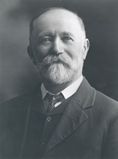| |
|
|
 |
Member for Darling (New South Wales) 1901-1917,
Darwin (Tasmania) 1917-1919 |
Born on the Orkney island of Eday, Scotland, William Spence arrived in Victoria in the early 1850s with his family. He is reputed to have witnessed the miners’ rebellion at Eureka in 1854 as a small boy. Spence worked as a miner from an early age and although he had no formal education, he read socialist treatises and preached in the Primitive Methodist Church and with the Bible Christians.
A leader in the formation of rural trade unions in Australia, Spence’s driving vision was to protect and promote the interests of workers of all kinds. He was instrumental in establishing such umbrella bodies as the Amalgamated Miners Association of Australasia, the Amalgamated Shearers Union of Australia, and ultimately the Australian Workers Union, of which he was Secretary 1894-98, and President 1898-1917. His role in unionising shearers and also in precipitating the maritime strike of 1890 made him an anathema to employers but a hero to pastoral workers. Spence was the member for Cobar in the New South Wales Legislative Assembly 1898-1901.
In 1901 Spence was elected to represent the federal seat of Darling for the Labor Party in the House of Representatives. Although Spence held ministerial office as Postmaster-General in the Fisher Government 1914-15 and was Vice-President of the Executive Council 1916-17, his reputation and influence among Labor supporters continued to rest on his achievements as a union organiser and on his inspirational vision of a united workforce.
Spence was forced to resign from the Labor Party in 1917 over the conscription issue, and subsequently lost his seat, but was returned to the House of Representatives as a Nationalist for the Tasmanian seat of Darwin in a by-election later that year. He was defeated in a contest for the seat of Batman, Victoria in 1919.
previous | list of members | next
|


